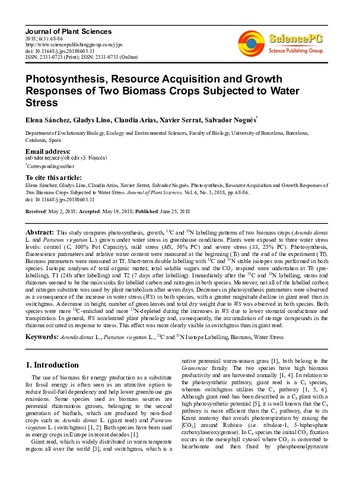Mostra el registre d'ítem simple
Photosynthesis, resource acquistion and growth responses of two biomass crops subjected to water stress
| dc.contributor.author | Sánchez Sánchez, Elena |
| dc.contributor.author | Lino Villanueva, Gladys |
| dc.contributor.author | Arias, Claudia |
| dc.contributor.author | Serrat, Xavier |
| dc.contributor.author | Nogués, Salvador |
| dc.contributor.other | Universitat Politècnica de Catalunya. Departament d'Enginyeria Agroalimentària i Biotecnologia |
| dc.date.accessioned | 2021-05-27T09:03:53Z |
| dc.date.available | 2021-05-27T09:03:53Z |
| dc.date.issued | 2018 |
| dc.identifier.citation | Sanchez, E. [et al.]. Photosynthesis, resource acquistion and growth responses of two biomass crops subjected to water stress. "Journal of Plant Sciences", 2018, vol. 6, núm. 3, p. 68-86. |
| dc.identifier.issn | 2331-0723 |
| dc.identifier.uri | http://hdl.handle.net/2117/346192 |
| dc.description.abstract | This study compares photosynthesis, growth, 13C and 15N labelling patterns of two biomass crops (Arundo donax L. and Panicum virgatum L.) grown under water stress in greenhouse conditions. Plants were exposed to three water stress levels: control (C, 100% Pot Capacity), mild stress (MS, 50% PC) and severe stress (SS, 25% PC). Photosynthesis, fluorescence parameters and relative water content were measured at the beginning (Ti) and the end of the experiment (Tf). Biomass parameters were measured at Tf. Short-term double labelling with 13C and 15N stable isotopes was performed in both species. Isotopic analyses of total organic matter, total soluble sugars and the CO2 respired were undertaken at T0 (prelabelling), T1 (24h after labelling) and T2 (7 days after labelling). Immediately after the 13C and 15N labelling, stems and rhizomes seemed to be the main sinks for labelled carbon and nitrogen in both species. Moreover, not all of the labelled carbon and nitrogen substrate was used by plant metabolism after seven days. Decreases in photosynthesis parameters were observed as a consequence of the increase in water stress (WS) in both species, with a greater magnitude decline in giant reed than in switchgrass. A decrease in height, number of green leaves and total dry weight due to WS was observed in both species. Both species were more 13C-enriched and more 15N-depleted during the increases in WS due to lower stomatal conductance and transpiration. In general, WS accelerated plant phenology and, consequently, the accumulation of storage compounds in the rhizome occurred in response to stress. This effect was more clearly visible in switchgrass than in giant reed |
| dc.format.extent | 19 p. |
| dc.language.iso | eng |
| dc.publisher | Science Publishing Group |
| dc.rights | Attribution-NonCommercial-NoDerivs 3.0 Spain |
| dc.rights.uri | http://creativecommons.org/licenses/by-nc-nd/3.0/es/ |
| dc.subject | Àrees temàtiques de la UPC::Enginyeria agroalimentària::Agricultura::Reg |
| dc.subject.lcsh | Irrigation |
| dc.subject.other | Arundo donax L. |
| dc.subject.other | Panicum virgatum L. |
| dc.subject.other | 13C and 15N Isotope Labelling |
| dc.subject.other | Biomass |
| dc.subject.other | Water Stress |
| dc.title | Photosynthesis, resource acquistion and growth responses of two biomass crops subjected to water stress |
| dc.type | Article |
| dc.subject.lemac | Regatge |
| dc.identifier.doi | 10.11648/j.jps.20180603.1 |
| dc.relation.publisherversion | http://www.sciencepublishinggroup.com/journal/paperinfo?journalid=215&doi=10.11648/j.jps.20180603.11 |
| dc.rights.access | Open Access |
| local.identifier.drac | 30770617 |
| dc.description.version | Postprint (published version) |
| dc.relation.projectid | info:eu-repo/grantAgreement/EC/FP7/289642/EU/Optimization of Perennial Grasses for Biomass Production/OPTIMA |
| local.citation.author | Sanchez, E.; Lino , G.; Arias , C.; Serrat, X.; Nogués , S. |
| local.citation.publicationName | Journal of Plant Sciences |
| local.citation.volume | 6 |
| local.citation.number | 3 |
| local.citation.startingPage | 68 |
| local.citation.endingPage | 86 |
| dc.description.sdg | Objectius de Desenvolupament Sostenible::12 - Producció i Consum Responsables |
| dc.description.sdg | Objectius de Desenvolupament Sostenible::13 - Acció per al Clima |
Fitxers d'aquest items
Aquest ítem apareix a les col·leccions següents
-
Articles de revista [1.060]


